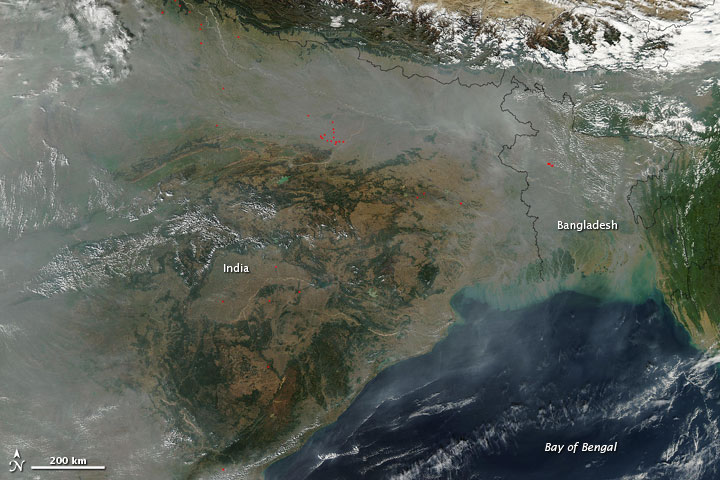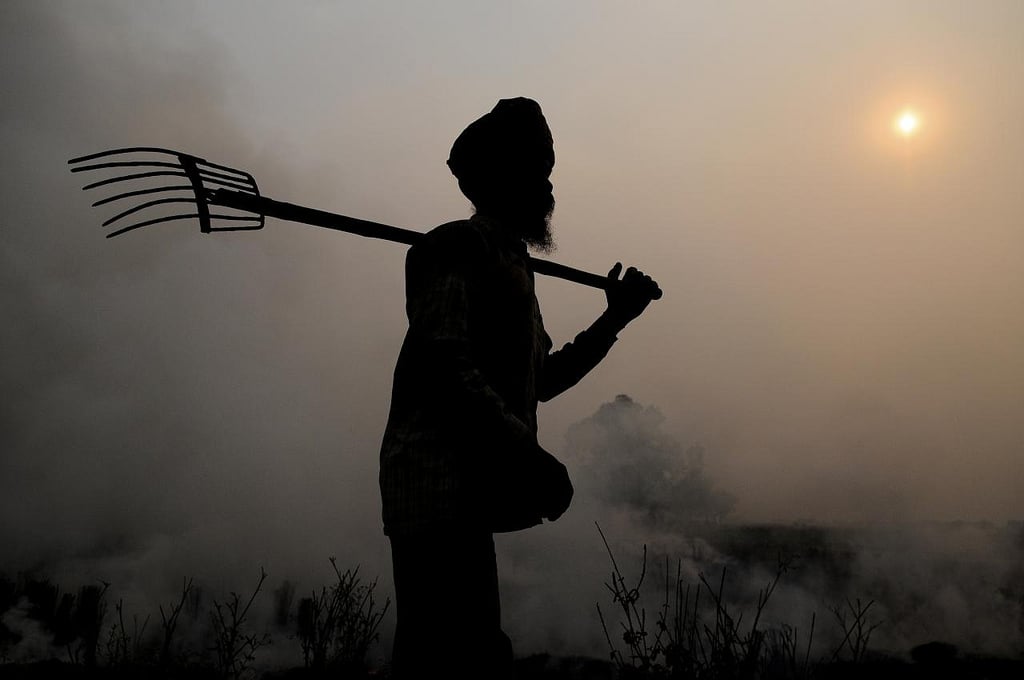It may seem far-fetched, but smoke from burning crops in Punjab and garbage in Nepal, along with fumes from vehicles, industry and brick kilns across South Asia reach the Himalayas, affecting the local environment, health and tourism that relies on views of the majestic ranges from Darjeeling in India to Nagarkot in Nepal.
Yet ground- and helicopter-based observations by scientists at the Nepal-based International Centre for Integrated Mountain Development (ICIMOD) point towards the long trail of polluting haze from the Indo-Gangetic plains into neighbouring Nepal and Bhutan, adding to the contribution from local fires within these countries.
Previous studies suggest this pollution may even contribute to glacier melt on the Tibetan plateau.
ICIMOD’s air quality monitoring team is now attempting to provide more concrete scientific evidence to back their initial observations. Beginning this winter, one set of studies will look at persistent winter fog in the Hindu Kush-Himalayas, which affects visibility and traps pollutants, while another will measure the atmospheric pollutants by setting up observatories.
Winter fog field campaign, mountain observatories
ICIMOD will coordinate a five-country study, beginning in December 2015, Arnico Panday, senior atmospheric scientist at ICIMOD, said at a regional workshop in November.
ICIMOD will initially begin the study in Nepal and Bhutan and later expand the monitoring sites to India, Pakistan and Bangladesh, says Panday who is also coordinating ICIMOD’s atmosphere initiative, which started in 2013 to promote understanding of and better polices around air pollution in the Hindu Kush Himalayan region.
This follows an initial pilot-scale study started last winter, from which the data is still being analysed.
The proposed winter fog study “is based on four pillars,” says Panday. These include monitoring the movements of tiny particles called ‘aerosols’ and collecting samples from across the region; mathematical modelling; satellite data analysis; and social science research to understand the impacts on and connections to human activities. Additionally, the scientists hope to set up a central archive of secondary data.
The initial sites for the winter fog campaigns include Lahore and Multan in Pakistan; Mohali, Pantnagar, Delhi, Agra, Kanpur, Varanasi and Dibrugarh in India; Lumbini and Kathmandu in Nepal; Pasakha in Bhutan, and Dhaka and Bhola in Bangladesh. Field campaigns typically involve multiple teams of scientists studying a specific problem for a limited duration.

The study involves scientists from the National University of Science and Technology (NUST) and Institute of Space Technology in Pakistan and the Indian Institute of Technology (IIT), Indian Institute of Tropical Meteorology and the Indian Institute of Science Education and Research (IISER). Scientists from the University of Dhaka and North-south University in Bangladesh, and delegates from Bhutan will also participate.
Scientists hope the winter fog field campaigns will add to insights to be gained from two long-term atmospheric observatories to be set up by ICIMOD at Gedu in Bhutan and Ichhyakamana in Nepal, which will measure polluting particles, ozone, soot or black carbon, and three greenhouse gases – carbon dioxide, methane and carbon monoxide.
Besides the measuring instruments, the sites will also house an automatic weather station to measure air temperature, humidity and pressure, wind speed and direction, rain and snow to see how these factors impact the spread of pollutants in the region.
Additional monitoring sites planned in Nepal include Langtang near the Yala glacier – one of the areas worst hit by the devastating earthquake in April – and in Lumbini near the Indo-Nepal border and in the Kathmandu valley, Panday says. In Bhutan, more sites are planned in capital Thimphu, Chele La, Pasakha and in eastern Bhutan.
ICIMOD’s efforts to expand air quality monitoring come amid growing concerns over the rising pollution in the Indian sub-continent and Himalayas and its impact on not only the environment, but also health, winter air travel and the mountain tourism in countries such as Nepal and Bhutan.
Temperatures from December to February drop below 10 degrees Celcius, causing widespread fog over north-eastern Bangladesh, India, and Pakistan – and area covering about 1500 kilometres, according to ICIMOD. Over the last two decades, there is a new trend of dense fog that persists continuously for many days, causing disruptions on roads, railways, and air traffic and accidents due to low visibility. The pollution also results in crop loss and cold waves that result in sickness and loss of lives in the region.
How haze spreads
The source and nature of pollution varies. Toxic fumes from industry, brick kilns, the widespread practice of burning crop stubble in open fields and small-scale burning of rubbish – all contribute to a polluting haze that merges with the winter fog to form ‘smog’.
Panday’s colleague Anita Karki explains how farmers in Punjab prefer to burn almost their fields as an easy and rapid way to get rid of the remains of rice crops. Punjab alone produces 21 million tonnes of stubble from 2.8 million hectares of rice and wheat.
Burning one tonne of crop residue releases 1,515 kg of carbon dioxide, 92 kg of carbon monoxide, 3.83 kg of nitric oxide, 0.4 kg of sulphur dioxide, 2.7 kg of methane and 15.7 kg of volatile organic compounds, estimates Karki. Leftover crops are later mixed with cow dung for use as cooking fuel, or in home fires to keep warm during winters.
Pollutants released from burning crops, a practice that is common not only in Punjab in Pakistan, and in Nepal, are also contributing to increased glacier melt in the region, according to a Swedish meteorologist Svante Bodin, European director of the International Cryosphere Climate Initiative.
On top of this, pollution from the increasing numbers of diesel-driven tractors and combine harvesters used by farmers in the area.
And then there is the diesel pumps for irrigation. “There are around 10 million diesel pumps in
Indo Gangetic plains, each working from 150‐200 hours and consuming one litre of diesel per hour,” says Karki.
Brick kilns are another major source of pollution. Brick kilns not only release soot, carbon dioxide and polluting particles, but also lead to land degradation and loss of agricultural top soil due to haphazard mining, says Bidya Banmali Pradhan, an atmospheric environment specialist at ICIMOD.
Pollution from the Indo Gangetic plain “often penetrates deep into the Himalayan valleys,” says Panday whose own observations have shown the haze reaches up to the peaks of Mount Everest.
Mountains trap pollution
Cities surrounded by mountains, such as Thimpu in Bhutan, Kathmandu in Nepal and Lanzhou in China, face particular challenges in managing air quality, because of mountain-induced weather conditions, says Panday.
Pollutants rapidly accumulate in cities in narrow valleys, as these cities have smaller volume of air for the pollutants to mix into.
Mountains also block ventilation. As a result, pollutants stay for a longer time and in higher concentrations in such cities.
Mountain environments also cool faster at night and the cold dense air travels down slopes to gather in valleys and confined basins. The resulting temperature inversion (with cold air at the bottom) suppresses vertical mixing of pollutants, he explains.
Monsoon clouds carry pollutants over foothill peaks and up valleys to the base of high peaks and on towards the Tibetan Plateau.
The preferred timing of burning, whether it is crop residues or local rubbish, adds to the problem. “Burning is usually done in the late afternoon, as it is believed that the burnt residue is a good fertilizer for the next harvest, kills the pests and drives away other insects and mosquitoes,” she says.
Similarly, the poor in Nepal prefer to burn waste in the evenings to keep warm. All this adds to pollutants settling during the night in the valley cites.
Of late, small private aviation clubs that rely on mountain tourism have had to cancel their flights due to poor visibility due to haze, says Panday.
No record of national emissions
For scientists, the challenge does not end with setting up air quality monitors. Most countries in the Hindu Kush-Himalayan region – Afghanistan, Bhutan, Myanmar, Nepal and Pakistan – do not have national emission inventories, observes Prakash Bhave, also from the Atmospheric Initiative.
In Bangladesh and India, university researchers sporadically develop emission inventories. And in China, emissions inventory is now a government function.
“After routine air quality monitors are installed, the next priority should be to construct and routinely update emission inventories for major pollutants”, he adds.
